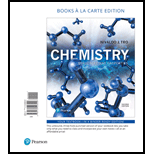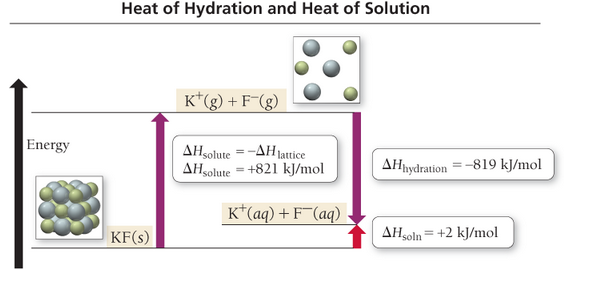
Chemistry: Structure And Properties, Books A La Carte Edition (2nd Edition)
2nd Edition
ISBN: 9780134528229
Author: Nivaldo J. Tro
Publisher: PEARSON
expand_more
expand_more
format_list_bulleted
Concept explainers
Textbook Question
Chapter 13, Problem 31E
When ammonium chloride (NH4Cl) is dissolved in water, the solution becomes colder.
a. Is the dissolution of ammonium chloride endothermic or exothermic?
b. What can you conclude about the relative magnitudes of the lattice energy of ammonium chloride and its heat of hydration?
c. Sketch a qualitative energy diagram similar to Figure 13.6 for the dissolution of NH4Cl.
d. Why does the solution form? What drives the process?

Expert Solution & Answer
Trending nowThis is a popular solution!

Students have asked these similar questions
Please provide steps to work for complete understanding.
Please provide steps to work for complete understanding.
Please provide steps to work for complete understanding.
Chapter 13 Solutions
Chemistry: Structure And Properties, Books A La Carte Edition (2nd Edition)
Ch. 13 - What is a solution? What are the solute and...Ch. 13 - What does it mean when we say that a substance is...Ch. 13 - Why do two ideal gases thoroughly mix when...Ch. 13 - Prob. 4ECh. 13 - Prob. 5ECh. 13 - Explain how the relative strengths of...Ch. 13 - What does the statement like dissolves like mean...Ch. 13 - Prob. 8ECh. 13 - What is the heat of hydration(Hhydration)? How...Ch. 13 - Prob. 10E
Ch. 13 - How does temperature affect the solubility of a...Ch. 13 - Prob. 12ECh. 13 - How does pressure affect the solubility of a gas...Ch. 13 - What is Henry’s law? For what kinds of...Ch. 13 - Prob. 15ECh. 13 - How are parts by mass and parts by volume used in...Ch. 13 - Prob. 17ECh. 13 - What is Raoult’s law? For what kind of...Ch. 13 - Explain the difference between an ideal and a...Ch. 13 - Prob. 20ECh. 13 - Prob. 21ECh. 13 - What are colligative properties?Ch. 13 - Prob. 23ECh. 13 - Explain the significance of the van’t Hoff factor...Ch. 13 - Prob. 25ECh. 13 - Pick an appropriate solvent from Table 13.3 to...Ch. 13 - Which molecule would you expect to be more soluble...Ch. 13 - Prob. 28ECh. 13 - Prob. 29ECh. 13 - Prob. 30ECh. 13 - When ammonium chloride (NH4Cl) is dissolved in...Ch. 13 - Prob. 32ECh. 13 - Prob. 33ECh. 13 - Use the given data to calculate the heats of...Ch. 13 - Lithium iodide has a lattice energy of...Ch. 13 - Prob. 36ECh. 13 - A solution contains 25 g of NaCl per 100.0 g of...Ch. 13 - A solution contains 32 g of KNO3 per 100.0 g of...Ch. 13 - Prob. 39ECh. 13 - A KCI solution containing 42 g of KCI per 100.0 g...Ch. 13 - Some laboratory procedures involving...Ch. 13 - A person preparing a fish tank fills the tank with...Ch. 13 - Prob. 43ECh. 13 - Scuba divers breathing air at increased pressure...Ch. 13 - Calculate the mass of nitrogen dissolved at room...Ch. 13 - Use Henry’s law to determine the molar solubility...Ch. 13 - An aqueous NaCl solution is made using 112 g of...Ch. 13 - Prob. 48ECh. 13 - To what volume should you dilute 50.0 mL of a...Ch. 13 - Prob. 50ECh. 13 - Silver nitrate solutions are used to plate silver...Ch. 13 - Prob. 52ECh. 13 - Prob. 53ECh. 13 - Prob. 54ECh. 13 - You can purchase nitric acid in a concentrated...Ch. 13 - You can purchase hydrochloric acid in a...Ch. 13 - Prob. 57ECh. 13 - Prob. 58ECh. 13 - Prob. 59ECh. 13 - Prob. 60ECh. 13 - Prob. 61ECh. 13 - Prob. 62ECh. 13 - Prob. 63ECh. 13 - Prob. 64ECh. 13 - A beaker contains 100.0 mL of pure water. A second...Ch. 13 - Which solution has the highest vapor pressure? a....Ch. 13 - Calculate the vapor pressure of a solution...Ch. 13 - A solution contains naphthalene (C10H8) dissolved...Ch. 13 - A solution contains 50.0 g of heptane (C7H16) and...Ch. 13 - A solution contains a mixture of pentane and...Ch. 13 - A solution contains 4.08 g of chloroform (C3H8O3)...Ch. 13 - A solution of methanol and water has a mole...Ch. 13 - Prob. 73ECh. 13 - An ethylene glycol solution contains 21.2 g of...Ch. 13 - Calculate the freezing point and melting point of...Ch. 13 - Calculate the freezing point and melting point of...Ch. 13 - An aqueous solution containing 17.5 g of an...Ch. 13 - An aqueous solution containing 35.9 g of an...Ch. 13 - Calculate the osmotic pressure of a solution...Ch. 13 - Prob. 80ECh. 13 - A solution containing 27.55 mg of an unknown...Ch. 13 - Prob. 82ECh. 13 - Calculate the freezing point and boiling point...Ch. 13 - Calculate the freezing point and boiling point in...Ch. 13 - What mass of salt (NaCl) should you add to 1.00 L...Ch. 13 - Prob. 86ECh. 13 - Use the van’t Hoff factors in Table 13.7 to...Ch. 13 - Prob. 88ECh. 13 - A 1.2-m aqueous solution of an ionic compound with...Ch. 13 - A 0.95-m aqueous solution of an ionic compound...Ch. 13 - Prob. 91ECh. 13 - Prob. 92ECh. 13 - Prob. 93ECh. 13 - An aqueous CaCl2 solution has a vapor pressure of...Ch. 13 - Prob. 95ECh. 13 - Prob. 96ECh. 13 - Potassium perchlorate (KClO4) has a lattice energy...Ch. 13 - Sodium hydroxide (NaOH) has a lattice energy of...Ch. 13 - Prob. 99ECh. 13 - Prob. 100ECh. 13 - Prob. 101ECh. 13 - Water softeners often replace calcium ions in hard...Ch. 13 - Prob. 103ECh. 13 - Prob. 104ECh. 13 - Prob. 105ECh. 13 - Prob. 106ECh. 13 - An isotonic solution contains 0.90% NaCl mass to...Ch. 13 - Prob. 108ECh. 13 - Prob. 109ECh. 13 - When HNO2 dissolves in water, it partially...Ch. 13 - Prob. 111ECh. 13 - Prob. 112ECh. 13 - Prob. 113ECh. 13 - Distillation is a method of purification based on...Ch. 13 - Prob. 115ECh. 13 - Find the mass of urea (CH4N2O) needed to prepare...Ch. 13 - A solution contains 10.05 g of unknown compound...Ch. 13 - Prob. 118ECh. 13 - Prob. 119ECh. 13 - Prob. 120ECh. 13 - The small bubbles that form on the bottom of a...Ch. 13 - The vapor above a mixture of pentane and hexane at...Ch. 13 - A 1.10-g sample contains only glucose (C6H12O6)...Ch. 13 - Prob. 124ECh. 13 - Two alcohols, isopropyl alcohol and propyl...Ch. 13 - A metal, M, of atomic mass 96 amu reacts with...Ch. 13 - Prob. 127ECh. 13 - Prob. 128ECh. 13 - A solution is prepared by dissolving 11.60 g of a...Ch. 13 - Substance A is a nonpolar liquid and has only...Ch. 13 - Prob. 131ECh. 13 - Prob. 132ECh. 13 - Prob. 133ECh. 13 - Prob. 134ECh. 13 - Prob. 135ECh. 13 - Have each group member make a flashcard with one...Ch. 13 - Prob. 137ECh. 13 - Prob. 138ECh. 13 - Prob. 139ECh. 13 - Prob. 140ECh. 13 - Which compound is most soluble in octane (C8H18)?...Ch. 13 - Prob. 2SAQCh. 13 - A 500.0-mL sample of pure water is allowed to come...Ch. 13 - Prob. 4SAQCh. 13 - Prob. 5SAQCh. 13 - Prob. 6SAQCh. 13 - What is the vapor pressure of an aqueous ethylene...Ch. 13 - Prob. 8SAQCh. 13 - What mass of glucose (C6H12O6) should you dissolve...Ch. 13 - Which aqueous solution has the highest boiling...Ch. 13 - The osmotic pressure of a solution containing 22.7...Ch. 13 - The enthalpy of solution for NaOH is -44.6 kJ/mol....Ch. 13 - A 2.4-m aqueous solution of an ionic compound with...Ch. 13 - A solution is an equimolar mixture of two volatile...Ch. 13 - An aqueous solution is in equilibrium with a...
Knowledge Booster
Learn more about
Need a deep-dive on the concept behind this application? Look no further. Learn more about this topic, chemistry and related others by exploring similar questions and additional content below.Similar questions
- Please provide steps to work for complete understanding.arrow_forwardIdentify the Functional Groups (FG) in the following molecules. Classify C atoms as tertiary, 30, or quaternary 40. Identify secondary 20 and tertiary, 30 hydrogen atoms. Please provide steps to undertand each labeling.arrow_forwardIdentify the Functional Groups (FG) in the following molecules. Classify C atoms as tertiary, 30, or quaternary 40. Identify secondary 20 and tertiary, 30 hydrogen atoms. Please provide steps to undertand each labeling.arrow_forward
- Identify the Functional Groups (FG) in the following molecules. Classify C atoms as tertiary, 30, or quaternary 40. Identify secondary 20 and tertiary, 30 hydrogen atoms. Please provide steps to undertand each labeling.arrow_forwardIdentify the Functional Groups (FG) in the following molecules. Classify C atoms as tertiary, 30, or quaternary 40. Identify secondary 20 and tertiary, 30 hydrogen atoms. Please provide steps to undertand each labeling.arrow_forwardA certain chemical reaction releases 24.7 kJ/g of heat for each gram of reactant consumed. How can you calculate what mass of reactant will produce 1460. J of heat? Set the math up. But don't do any of it. Just leave your answer as a math expression. Also, be sure your answer includes all the correct unit symbols. mass M 0.0 x μ 00 1 Garrow_forward
- a) Propose a method to synthesize the following product. More than one step reaction is required. (10 marks)arrow_forwardthe vibrational frequency of I2 is 214.5 cm-1. (i) Using the harmonic oscillator model, evaluate the vibrational partition function and the mean vibrational energy of I2 at 1000K. (ii) What is the characteristic vibrational temperature of I2? (iii) At 1000K, assuming high-temperature approximation, evaluate the vibrational partition function and the mean vibrational energy of I2. (iv) Comparing (i) and (iii), is the high-temperature approximation good for I2 at 1000K?arrow_forwardPlease correct answer and don't used hand raitingarrow_forward
arrow_back_ios
SEE MORE QUESTIONS
arrow_forward_ios
Recommended textbooks for you
 Chemistry: Principles and PracticeChemistryISBN:9780534420123Author:Daniel L. Reger, Scott R. Goode, David W. Ball, Edward MercerPublisher:Cengage LearningChemistry: Matter and ChangeChemistryISBN:9780078746376Author:Dinah Zike, Laurel Dingrando, Nicholas Hainen, Cheryl WistromPublisher:Glencoe/McGraw-Hill School Pub Co
Chemistry: Principles and PracticeChemistryISBN:9780534420123Author:Daniel L. Reger, Scott R. Goode, David W. Ball, Edward MercerPublisher:Cengage LearningChemistry: Matter and ChangeChemistryISBN:9780078746376Author:Dinah Zike, Laurel Dingrando, Nicholas Hainen, Cheryl WistromPublisher:Glencoe/McGraw-Hill School Pub Co Chemistry: The Molecular ScienceChemistryISBN:9781285199047Author:John W. Moore, Conrad L. StanitskiPublisher:Cengage Learning
Chemistry: The Molecular ScienceChemistryISBN:9781285199047Author:John W. Moore, Conrad L. StanitskiPublisher:Cengage Learning ChemistryChemistryISBN:9781305957404Author:Steven S. Zumdahl, Susan A. Zumdahl, Donald J. DeCostePublisher:Cengage Learning
ChemistryChemistryISBN:9781305957404Author:Steven S. Zumdahl, Susan A. Zumdahl, Donald J. DeCostePublisher:Cengage Learning Chemistry: An Atoms First ApproachChemistryISBN:9781305079243Author:Steven S. Zumdahl, Susan A. ZumdahlPublisher:Cengage Learning
Chemistry: An Atoms First ApproachChemistryISBN:9781305079243Author:Steven S. Zumdahl, Susan A. ZumdahlPublisher:Cengage Learning

Chemistry: Principles and Practice
Chemistry
ISBN:9780534420123
Author:Daniel L. Reger, Scott R. Goode, David W. Ball, Edward Mercer
Publisher:Cengage Learning

Chemistry: Matter and Change
Chemistry
ISBN:9780078746376
Author:Dinah Zike, Laurel Dingrando, Nicholas Hainen, Cheryl Wistrom
Publisher:Glencoe/McGraw-Hill School Pub Co

Chemistry: The Molecular Science
Chemistry
ISBN:9781285199047
Author:John W. Moore, Conrad L. Stanitski
Publisher:Cengage Learning

Chemistry
Chemistry
ISBN:9781305957404
Author:Steven S. Zumdahl, Susan A. Zumdahl, Donald J. DeCoste
Publisher:Cengage Learning

Chemistry: An Atoms First Approach
Chemistry
ISBN:9781305079243
Author:Steven S. Zumdahl, Susan A. Zumdahl
Publisher:Cengage Learning

Solutions: Crash Course Chemistry #27; Author: Crash Course;https://www.youtube.com/watch?v=9h2f1Bjr0p4;License: Standard YouTube License, CC-BY